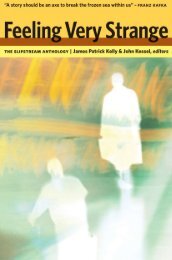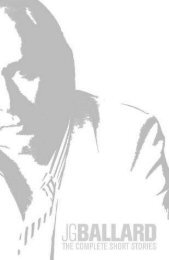The Curse of the Wer.. - Site de Thomas - Free
The Curse of the Wer.. - Site de Thomas - Free
The Curse of the Wer.. - Site de Thomas - Free
You also want an ePaper? Increase the reach of your titles
YUMPU automatically turns print PDFs into web optimized ePapers that Google loves.
WEREWOLVES AND SCHOLARS<br />
Phillpotts’s skilful manipulation <strong>of</strong> <strong>the</strong> werewolf <strong>the</strong>me foregrounds<br />
<strong>the</strong> equivocation that had come to characterize <strong>the</strong> subject <strong>of</strong> lycanthropy.<br />
By exposing <strong>the</strong> werewolf’s unique proclivity for articulating<br />
uncertainty about <strong>the</strong> limitations <strong>of</strong> materialist explanations, <strong>the</strong> text<br />
also hints at <strong>the</strong> inter<strong>de</strong>pen<strong>de</strong>nce <strong>of</strong> monstrosity and mo<strong>de</strong>rnity. A<br />
number <strong>of</strong> scholars have consi<strong>de</strong>red <strong>the</strong> ‘mo<strong>de</strong>rnity’ <strong>of</strong> monsters, arguing<br />
that <strong>the</strong> ‘monstrous’ or ‘spectral’ element that haunted scientific<br />
discourse <strong>de</strong>spite all attempts to dispel it was due to <strong>the</strong> processes by<br />
which rational science worked to <strong>de</strong>scribe ‘reality’. As <strong>the</strong> following<br />
chapter <strong>de</strong>monstrates, <strong>the</strong> ‘real’ is seen within such frameworks to be<br />
constructed through <strong>the</strong> <strong>de</strong>nial or exclusion <strong>of</strong> certain material, which<br />
‘returns’ in uncanny forms such as monsters, to unsettle ‘reality’. This<br />
logic suggests that <strong>the</strong> supernatural or <strong>the</strong> Gothic is a si<strong>de</strong> effect <strong>of</strong><br />
<strong>the</strong> process by which reality is produced.<br />
Slavoj Žižek takes such <strong>the</strong>orizing fur<strong>the</strong>r, by arguing that <strong>the</strong> stuff<br />
<strong>of</strong> Gothic is in fact central to formations <strong>of</strong> <strong>the</strong> ‘real’: ‘<strong>The</strong>re is no<br />
reality without <strong>the</strong> spectre; … <strong>the</strong> circles <strong>of</strong> reality can be closed only<br />
by means <strong>of</strong> an uncanny spectral supplement.’ 106 Following this logic,<br />
‘reality’ is always a social fiction, incapable <strong>of</strong> wholly ‘covering’ <strong>the</strong><br />
real, because <strong>the</strong>re is always an element that is repressed, which <strong>the</strong>n<br />
manifests in spectral form to ‘complete’ social reality (and for Žižek,<br />
this repressed element is <strong>the</strong> only real). In this sense, <strong>the</strong> various<br />
‘explanations’ <strong>of</strong> lycanthropy mo<strong>de</strong>lled competing versions <strong>of</strong> ‘reality’;<br />
and competition between various exponents was a competition for a<br />
‘neutral’ ground from which <strong>the</strong> real could be <strong>de</strong>scribed and observed.<br />
But that ground remained elusive, because <strong>the</strong> repressed real, given<br />
shape through <strong>the</strong> supernatural, <strong>the</strong> spectre — <strong>the</strong> werewolf — remained<br />
perpetually outsi<strong>de</strong> <strong>the</strong> ‘reality’ that was quested after. And as <strong>the</strong><br />
werewolf kept coming back, so uncertainty grew about <strong>the</strong> explanatory<br />
power <strong>of</strong> rational science.<br />
43





